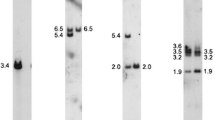Summary
Tyrosine aminotransferase (TAT; EC 2.6.1.5) is a liver enzyme involved in amino acid metabolism and gluconeogenesis. Low levels of TAT have been implicated in several inherited disorders, particularly tyrosinemia II (Richner-Hanhart syndrome). We have determined the chromosomal location of the human TAT gene by Southern blot hybridization analysis of DNAs from 18 humanxrodent hybrid cell lines, using a rat cDNA probe. The results indicate that the TAT gene maps to chromosome 16. Analysis of two hybrids containing a rearranged chromosome 16 allowed assignment of the TAT locus to 16q22→24. In situ hybridization to human metaphase chromosomes confirmed this regional assignment.
Similar content being viewed by others
References
Andersson SM (1982) Induction of cytosolic tyrosine aminotransferase by dexamethasone in organ culture of fetal human liver. Early Hum Dev 6:165–169
Andersson SM, Pispa JP (1982) Purification and properties of human liver tyrosine aminotransferase. Clin Chim Acta 125:117–123
Bohnert A, Anton-Lamprecht I (1982) Richner-Hanhart's syndrome: ultrastructural abnormalities of epidermal keratinization indicating a causal relationship to high intracellular tyrosine levels. J Invest Dermatol 79:68–74
de Martinville B, Wyman AR, White R, Francke U (1982) Assignment of the first random restriction fragment length polymorphism (RFLP) locus (D14S1) to a region of human chromosome 14. Am J Hum Genet 34:216–226
Feinberg AP, Vogelstein B (1983) A technique for radiolabelling DNA restriction endonuclease fragments to high specific activity. Anal Biochem 132:6–13
Francke U (1984) Random X inactivation resulting in mosaic nullisomy of region Xp21.1→p21.3 associated with heterozygosity for ornithine transcarbamylase deficiency and for chronic granulomatous disease. Cytogenet Cell Genet 38:298–307
Francke U, Pellegrino M (1977) Assignment of the major histocompatibility complex to a region of the short arm of human chromosome 6. Proc Natl Acad Sci USA 74:1147–1151 and 5776 (correction)
Francke U, Busby N, Shaw D, Hansen S, Brown MG (1976) Intrachromosomal gene mapping in man: assignment of nucleoside phosphorylase to region 14cen→14q21 by interspecific hybridization of cells with a t(X;14)(p22;q21) translocation. Somatic Cell Genet 2:27–40
Harper ME, Saunders GF (1981) Localization of single-copy DNA sequences on G-banded chromosomes by in situ hybridization. Chromosoma 83:431–439
Hashimoto S, Schmid W, Schütz G (1984) Transcriptional activation of the rat liver tyrosine aminotransferase gene by cAMP. Proc Natl Acad Sci USA 81:6637–6641
Koontz JW (1984) The role of the insulin receptor in mediating the insulin-stimulated growth response in Reuber H-35 cells. Mol Cell Biochem 58:139–146
Lalley P, McKusick VM (1985) Report of the Committee on Comparative Mapping. In: Human Gene Mapping 8. Cytogenet Cell Genet 40:536–566
Machino H, Miki Y, Kawatsu T, Kida K, Matsuda H (1983) Successful dietary control of tyrosinemia II. J Am Acad Dermatol 9:533–539
Müller G, Scherer G, Zentgraf H, Ruppert S, Herrmann B, Lehrach H, Schütz G (1985) Isolation, characterization and chromosomal mapping of the mouse tyrosine aminotransferase gene. J Mol Biol 184:367–373
Ohisalo JJ, Laskowska-Klita T, Andersson SM (1982) Development of tyrosine aminotransferase and para-hydroxyphenylpyruvate dioxygenase activities in fetal and neonatal human liver. J Clin Invest 70:198–200
Pearson SJ, Tetri P, George DL, Francke U (1983) Activation of human α1-antitrypsin gene in rat hepatoma x human fetal liver cell hybrids depends on presence of human chromosome 14. Somatic Cell Genet 9:567–592
Roth RA, Maddux B (1983) Insulin-cholera toxin binding unit conjugate: a hybrid molecule with insulin biological activity and cholera toxin binding specificity. J Cell Physiol 115:151–158
Scherer G, Schmid W, Strange CM, Röwekamp W, Schütz G (1982) Isolation of cDNA clones coding for rat tyrosine aminotransferase. Proc Natl Acad Sci USA 79:7205–7208
Shinomiya T, Scherer G, Schmid W, Zentgraf H, Schütz G (1984) Isolation and characterization of the rat tyrosine aminotransferase gene. Proc Natl Acad Sci USA 81:1346–1350
Southern E (1979) Gel electrophoresis of restriction fragments. Methods Enzymol 68:152–164
Spencer CJ, Heaton JH, Gelehrter TD Richardson KI, Garwin JL (1978) Insulin selectively slows the degradation rate of tyrosine aminotransferase. J Biol Chem 253:7677–7682
Author information
Authors and Affiliations
Rights and permissions
About this article
Cite this article
Barton, D.E., Yang-Feng, T.L. & Francke, U. The human tyrosine aminotransferase gene mapped to the long arm of chromosome 16 (region 16q22→q24) by somatic cell hybrid analysis and in situ hybridization. Hum Genet 72, 221–224 (1986). https://doi.org/10.1007/BF00291881
Received:
Issue Date:
DOI: https://doi.org/10.1007/BF00291881




